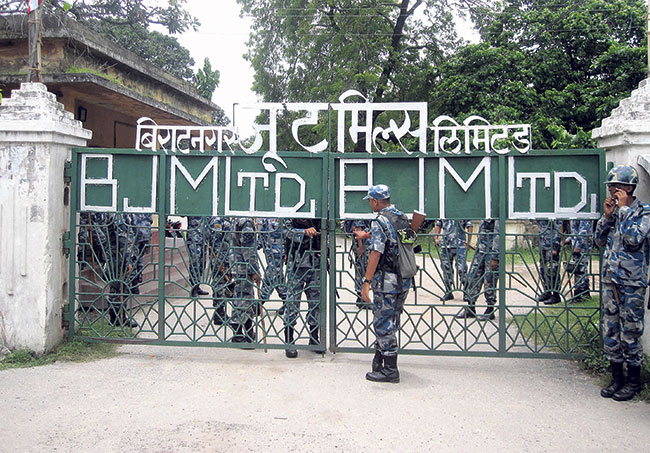BIRATNAGAR, Nov 4: Radha Krishna Chimariya, an industrialist from Calcutta, India used to run a large jute mill at Katihar city near Nepal-India border. Haridwari Malla used to work as a manager of the mill. The area, being near the Koshi River, was good for jute farming. Malla took a go-down on lease in Biratnagar, bordering town of Nepal.
 Ramlal Golchha, initiator of the famous Nepali business house Golchha Organization, used to supply Nepali jute to the Katihar jute mill. He had taken the go-down of a local, Durganidhi Lohani, on lease.
Ramlal Golchha, initiator of the famous Nepali business house Golchha Organization, used to supply Nepali jute to the Katihar jute mill. He had taken the go-down of a local, Durganidhi Lohani, on lease.
After realizing the potential of jute farming in Nepal, traders, who had been exporting jute to India, proposed to establish a jute mill in Biratnagar during the visit of then Rana prime minister. Finally they got permission to establish a jute mill in Biratnagar after two-year-long effort.
“Their effort was successful in establishing the first jute mill of the county at Rani, Biratnagar in 1993,” said jute expert Mohan Chandra Ghimire. Later the whole area around the mill started to be known as Mills’ Area.
Biratnagar Jute Mills had been established with 75 percent investment of Indian investor Chimariya and 25 percent shares of Nepali investors. From the very beginning, the Ranas kept their shares. During the establishment of the industry, Nepal government had eight percent shares. Later, the number of shareholders reached to 172.
Govt shareholding in Biratnagar Jute Mills comes down to 23.9 p...

“Nepal did not have a bank during those days, so the industry used to do business through Imperial Bank of India,” Dipak Lohani, a shareholder of the mill told Republica. For the import and export of jute in third countries, a letter of credit (LC) was issued for the first time in Nepal in the name of Biratnagar Jute Mill, Lohani said. “That time we had brought officials from Calcutta to issue LC as we were unknown about the process of LC,” he added.
Establishment of the mill showed the way for other industries to come into existence. Both the government and the private sector started opening up factories in Nepal.
“As a requirement of the mill, Nepal’s first financial organization was opened,” Lohani recalled.
Biratnagar Jute Mill became the major source of income for jute farmers of Jhapa, Morang, Sunsari and Saptari districts.
However, the first industry of the country gradually came under heavy political interference and issues such as lack of capital, problems of raw materials, government’s negligence, and corruption started to crop up.
The Nepali management stopped giving subsidy to the farmers, which the Indians used to give. This led to shortage of raw material for the industry. Nepal had to pay expensive costs to import jute from India and Bangladesh. Earlier, when the farmers got subsidy, they used to supply 45 percent of the raw material required for the mill.
The dwindling mill started making losses. The government then appointed Gopal Man Shrestha as its chief executive officer in 1982. However, he also could not manage the industry due to lack of capital investment. In 1987, the mill got a little breath of life when C P Lohani, the Nepali husband of Indian actress Mala Sinha, took the responsibility of the mill. The production saw an increment for a while.
But then, the country went through political changes and multiparty democracy was in place in 1990. Political interference started again, and the government started to appoint chairman for the factory. Since 1991, shareholders gradually pulled off their shares from mill.
During the nine-month rule of CPN-UML, Subodhraj Pyakurel was appointed the chairperson of the factory. With a government funding of Rs 80 million, he bought all the shares from the Indian shareholders.
After that, the jute mill fully came under Nepali ownership. But along with that, political interference reached new heights. It became a political hub. The incumbent minister for industry would appoint a cadre from his party as the mill’s chairman. With each change of government, the chairman was changed and party cadres were recruited as the staff. It became a place to start political movements. At a time when plastic is replacing jute and jute mills of Calcutta and Bangladesh are dominating the market with modern practices, Nepal’s first industry is on the verge of extinction.
Recently, a new issue has cropped up that is set to further ruin the mill. The government-owned shares of the mill are sold to private individuals. Some government officials are involved in that. As a result, the government’s 68 percent shares have come down to about 24 percent.
Ten persons, including secretary Dinesh Kumar Thapaliya and joint secretary Uddav Prashad Timilsina of the Ministry of Federal Affairs and Local Development, have bought promoter shares of the mill. The private sector shares have now reached about 66 percent, including those of Thapaliya and Timilsina.
“People are eying to capture the land and machinery of the mill that is worth more than Rs 5 billion in current valuation,” a shareholder said. “That is the motive behind the recent transfer of shares.”








































